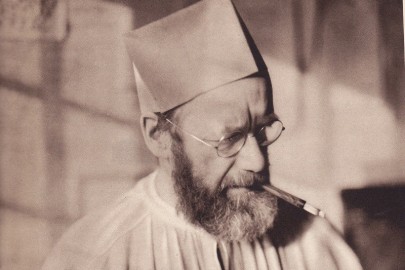
Toby Ferris rummages through the orchestra’s changing cast of instruments and finds some half-forgotten but powerful beliefs.
The modern symphony orchestra is a ritual instrument of considerable, sometimes alarming incantatory power.
In Roumeli (1966) Patrick Leigh Fermor describes the two kinds of flute in use among the Sarakatsani, a dwindling group of transhumant shepherds in Northern Greece. The first is no more than the sawn-off barrel of a shotgun with drilled finger holes. It is, or was, an everyday instrument. The second “is made from the longest bone from an eagle’s wing. We know that this bird is abominated. I think Yorgo’s flute was one of these. After shooting the eagle and cleaning the wing-bone by burying it, he would have had to neutralise its wicked mana by leaving it under an altar for forty days of purification and exorcism before daring to drill the stop-holes and put it to his lips.”
I would like to make the harmless and idle observation that if in its Renaissance and Baroque origins the orchestra resembled the former of these two flutes, being a pragmatic assembly of sound machines culled from whatever bits and pieces lay to hand; then in its current ossified, purified form it more nearly resembles the latter.
Ritual is associated with a hardening of a cultural practice, and while the orchestra has undergone considerable local and historical variation it remains, for the most part, pickled. The Vienna Philharmonic, for instance, takes a notably stubborn pride in its aspic tradition. Women were only very recently admitted to the ranks of the orchestra; it maintains banks of wind instruments which diverge markedly in structure from the more universally accepted models (in particular the oboe and horn) with different bores, reed assemblies, mouthpieces and leadpipes, and valve systems and fingering; playing techniques of both strings and wind instruments are highly typical and are handed down from within the orchestra; and the drums, in proper Sarakatsani manner, are of finest stretched goat hide.
It was not always so. Music, dance, religion and ritual are invariably linked in human cultures, but at any given historical moment the need to draw down talismanic sympathies is more or less overt, more or less experimental. Broadly speaking, from the Renaissance to roughly the second half of the eighteenth century the piecing together of an ensemble was an ad hoc business: the standardised instrumental group was still a burgeoning, crystallising, mutational affair, as were the rituals and contexts of performance. Instruments and groups of instruments came and went.
Thus, as noted in the Anatomy of Norbiton:
The lira da braccio, with its two drone strings (bourdons), belongs to a now-defunct evolutionary branch of stringed instruments, pushed from their niche, I suppose, by the more muscular, more Neanderthal viols, which in their turn were superseded by the hyper-intelligent violin family.
Attending a concert of Renaissance music is much like visiting the Natural History Museum.
Your eye wanders over the stage, spotting the extinct grotesques, the parping, flapping, cumbrous curiosities, and you try in vain to name them – Sackbut? Theorbo? Oboe da caccia? Basset Pommer? Tromba marina? Hurdy-Gurdy? – as you might, in a museum of bones, struggle to pick out the auroch or the glytodon.
Of course new instruments are added to the symphony orchestra from time to time – Berlioz’s ophicleide, for instance, or the Wagner tuba – but then tribal ritual is usually susceptible of local adornment, so long as the core of beliefs is protected.
And what is the core of beliefs which our orchestra enshrines if not a residuum of that peculiar Enlightenment melange of rationality and mysticism – a conviction of the philosophical order to which music, in its highest forms, can contribute, and the fraternal, masonic quest for wisdom which it can embody and inspire? According to this account, Beethoven is neither a man, nor a set of possible experiences, but a Rational Virtue.
Thus it is, according to this narrative, that it has been necessary slowly to exorcise the Berlin Philharmonic of the spirits of Furtwängler and Karajan, by electing first Claudio Abbado with his priestly-urbane ministrations, then Sir Simon Rattle with his antique honorific and his shamanic wild mumbo-jumbo hair – necessary because Furtwängler conducting Beethoven, Wagner and Mozart for the Nazis was at best an ambiguous and at worst a perfectly appropriate use of the ritual object.
And thus it is, similarly, that the attempts of Daniel Barenboim and Edward Said to bring peace to the Middle East through the West-Eastern Divan, or of the sistema in Venezuela to drag lost youth from the barrios, is predicated, not on the more modern virtue-systems of teamwork and application, but on an atavistic belief in the capacity of the orchestra to connect us with a version of civic order we have half forgotten about, half shuffled free of, and value the more viscerally in consequence.









Thank you for a thought provoking piece Toby, I hadn’t ever considered the darwinian survival struggle of orchestral instruments, with the various evolutionary cul-de-sacs withering away occasionally. Gittern anyone?
This intriguing post reminds me that at the weekend I was musing along similar lines about the construction of a rugby team. How did the melee of the game gradually turn into number 8s and fly-halves etc. And then solidify to the point where you can identify a player’s position by his body shape…
That is a very interesting question indeed, and I suppose the answer would look something like the explanations for changing fielding patterns in cricket, or formations in assoc. football – i,e evolutionary lag between attack and defence (attack proposes a problem, defence finds a solution, along the cheetah/gazelle model) with legislation thrown in from time to time, becuase the authorities love to meddle – I recall reading in Bill Bowes’ autobiography of his disgruntlement at the legislated response to leg theory, on the basis that, sooner or later, the batsmen would have worked out a solution (as Bradman in fact started to do very rapidly, and as batsmen had done a generation or two earlier with the advent of ‘off’ theory).
Of course there’s no knowing what the emergent effects of any given rule change will be (as witness the recent experimental rule changes in rugby which had the unforeseen effect of players not wanting to run the ball into contact for fear of turnover at the breakdown, a change favouring the hoofers at fullback, among other things) – but with a little cack-handed guidance from the committees I can imagine players and teams rapidly working out how best the mechanics of a given setplay will work – thus short-legged broad-backed props, gormless giants in the second row, and so on).
Having said all that, one thing that’s emerged in the last few years is that tall and fast are pretty much the way to go in any position – thus Mike Philips, Roberts and that other giant Wales have at centre, any number of giant wings worldwide. The Peter Stringers and Shane Williamses of the world have their days numbered, at least until the next rule change.
But as Frank Key says, must we? So I’ll leave it there
Something I have always found unusual about rugby is the complicit ‘ghettoisation’ of each position, where forwards are told that they are clumsy oafs who should never try to run, kick or do anything ‘skilfull’ This percolates through the whole game and in every TV game you’ll hear the commentators tutting and laughing at a prop who has tried to run with the ball. But theres no reason why a forward can’t also be a good kicker or passer, yet they are automatically assumed not to be
From what I’ve read, Toby, that does indeed seem to have been the process: particular teams, sometimes in particular matches (often on tour) have introduced a new formation or division of labour which has caught on because it had proven effective.
Regarding the increasing size of players I think this is an environmental factor, i.e. each generation is bigger than the last and professionalism has given players the time and resources to add bulk. South African teams have always been bigger because they eat lots of steak and have always been ‘shamateurs’.
Shane Williams, rather strangely, benefitted from this process: he was regarded as too small for international rugby but trained himself up to be a little pocket battleship. I think there will always be a place for the smaller man in rugby – elusiveness will always be at a premium and, you know, the bigger they are the harder they fall. The World Cup Finalists France still boast plenty of, as my wife calls them (annoyingly), ‘little cuties’.
I wonder which currently emergent sports or art forms are still a ‘burgeoning, crystallising, mutational affair’.